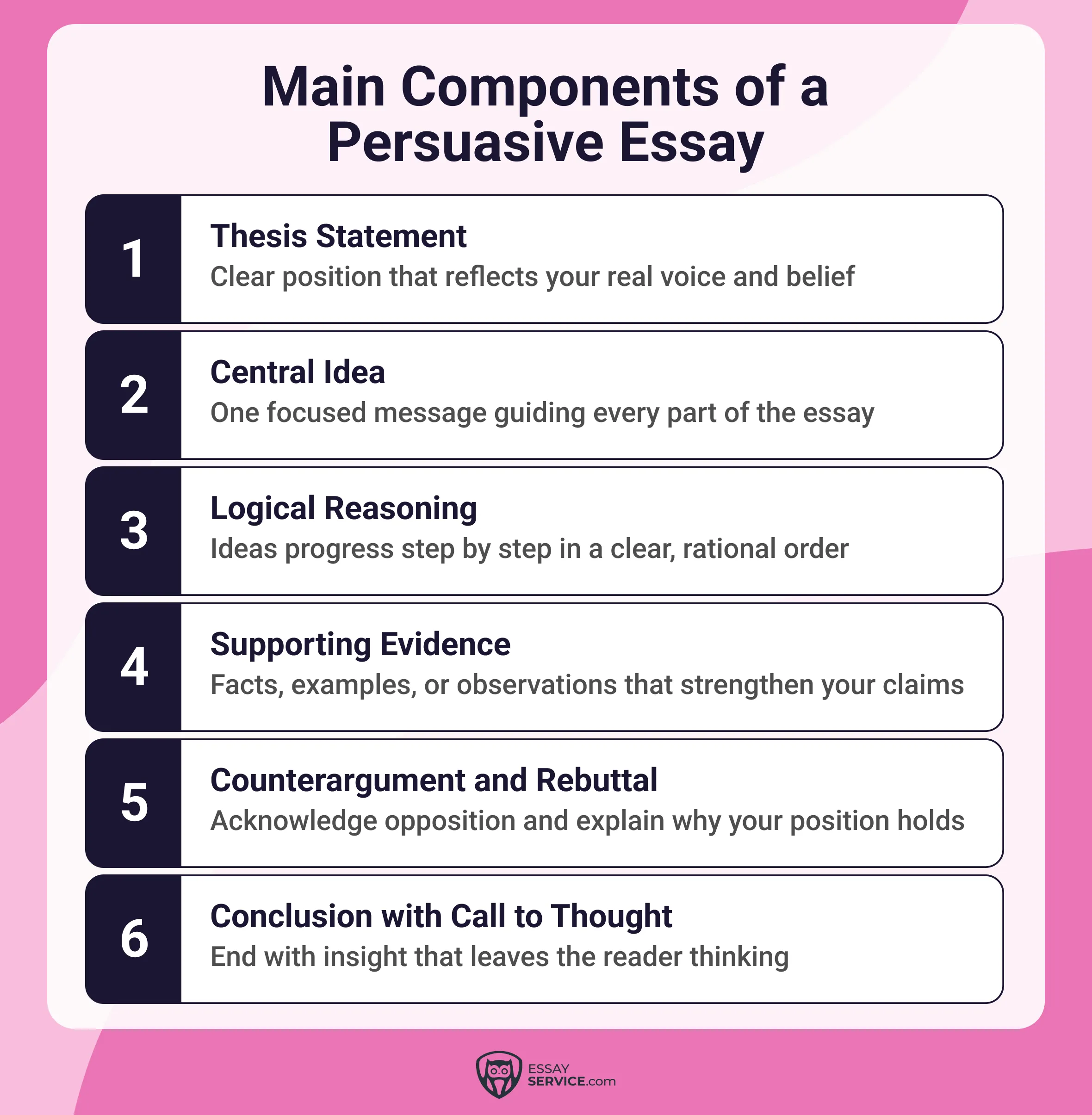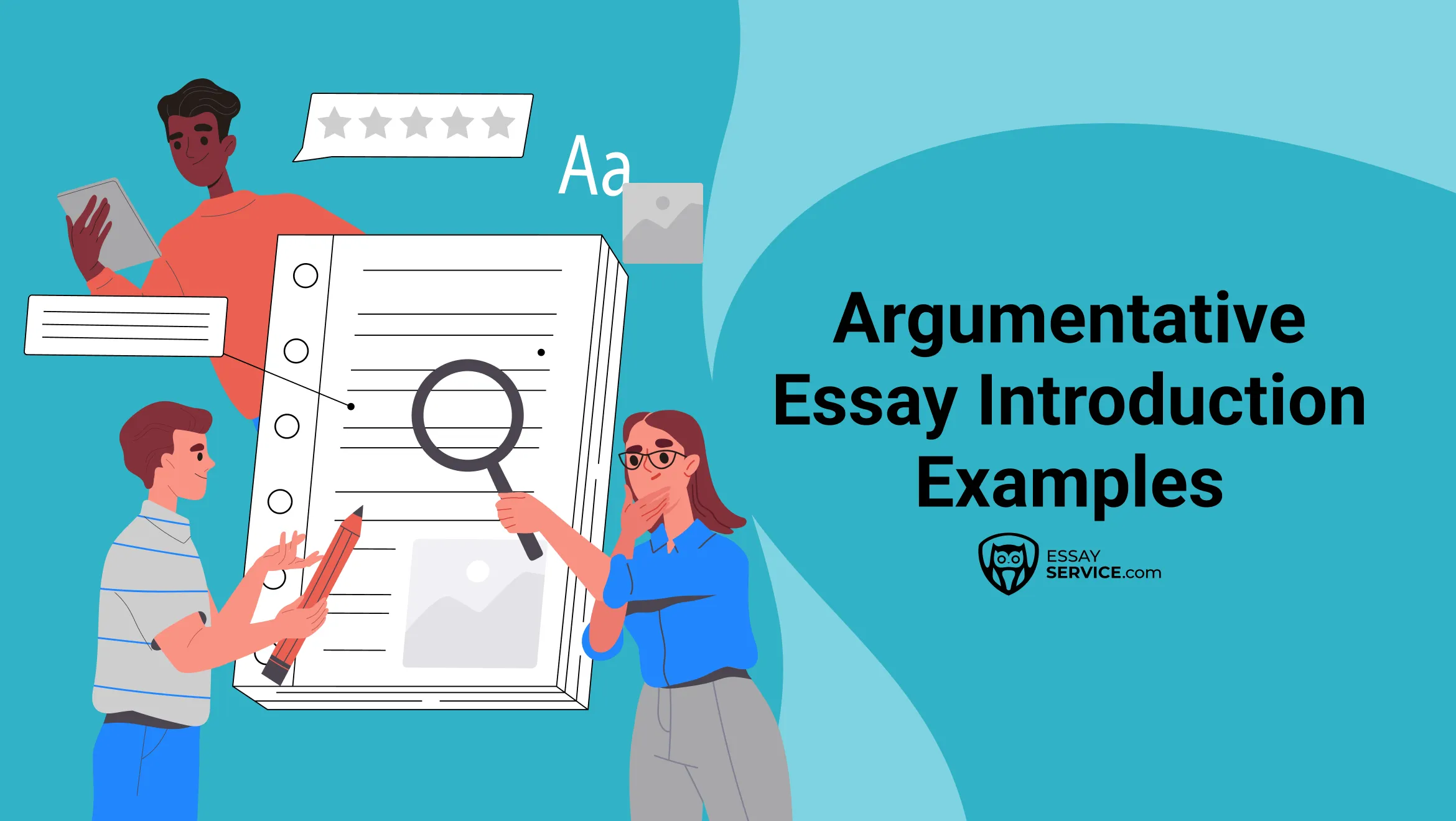Key Takeaways
- Real persuasive essay examples you can learn from
- Topics range from simple opinions to deep, thoughtful arguments
- Essays are grouped by school level and format for easy reference
- Each one shows how strong structure and clear thinking work together
- Tips included to help you write your own persuasive essay
Trying to convince someone of your point is hard enough in real life. But doing it in writing is what takes real skill. This is the type of essay that needs an exceptionally clear structure, strong logic, and convincing language.
With this article, we’ll help you explore persuasive essay examples that actually work. You’ll see what well-structured writing looks like at different grade levels. Examples of a persuasive essay in this article show how to present strong arguments and teach you how to build an essay that stays with the reader long after the final sentence.
If writing feels like one of those things you just can’t get past, no matter how many times you try, EssayService has your back. Our real writers are here to help you figure it all out and make it work.


EssayService Helps Your Argument Land
Clear reasoning, solid evidence, and persuasive structure all in one place.
Persuasive Essay Examples for Students
Looking at real examples can help more than any writing guide. You get to see how someone took a stance, built their argument, and made it all flow in the persuasive essay examples PDF files below.
Persuasive Essay Examples for Elementary School
At the elementary level, young writers should focus on easy-to-follow reasons. This is the point where kids start to learn how to think and form their ideas. The goal, of course, isn’t perfection. These good persuasive essay examples show how kids can express real opinions in their own words, using logic that makes sense to them.
Persuasive Essay Examples for Middle School
Middle schoolers, with persuasive essays, learn how to back up their ideas, think critically, and start recognizing the other side. These examples for persuasive essay show how real middle schoolers can argue clearly, build structure, and explain why their point of view matters.
Persuasive Essay Examples for High School
By the time students reach high school, creating a persuasive essay becomes more about learning to argue with purpose than just proving a point. Each example of persuasive essay below demonstrates how students can make strong arguments about the things that matter most to them.
If you need inspiration or want to explore a wider range of ideas, this list of persuasive essay topics can help you find subjects that invite thoughtful debate.
College Persuasive Essay Examples
College-level writing is something else entirely. Persuasive essays now ask students to do thorough research, gain real-world awareness, and implement strong logic into their arguments. At this stage, students speak to wider audiences outside classes. These persuasive essay samples blend personal voice with thoughtful analysis, just like any solid persuasive essay should.
Persuasive Essay Examples of Different Formats
As important as the actual content is, structure matters, too. There are two main types: three-paragraph essays and five-paragraph ones. The latter gives more time to explore an idea, while the shorter one requires more brief and focused reasoning. Below are two samples of persuasive essays:
Stronger Persuasive Essays Start With EssayService
Receive our expert guidance for arguments that sound clear, balanced, and convincing.
What Makes a Good Persuasive Essay?
A good persuasive essay doesn’t just say what you think. It makes someone else stop, listen, and maybe even nod along. You’re trying to open someone’s mind a little, and that takes more than just strong opinions.
Here’s what helps:
- A persuasive essay outline that keeps ideas focused and easy to follow
- A clear, honest statement of what you believe
- Thoughtful reasons that feel real, not forced
- Examples that help your reader picture the point, not just read it
- A bit of feeling, but not too much, just enough to connect
- A structure that flows like a real conversation
- A quick glance at the other side, to show you’re being fair
- Specific moments or personal details that make the writing feel alive
- An ending that leaves a mark, not loud, but something that sticks
Main Components of a Persuasive Essay
The best persuasive essays don’t shout. They feel more like a conversation with someone who sees the world a little differently and makes you wonder if they might be onto something.

Thesis Statement
A thesis has to be something meaningful, not something that sounds academic. Not what you think your teacher wants. Pick the topic that unsettles you a little. That’s where your voice gets louder, and your writing gets real.
Central Idea or Controlling Argument
Everything in the essay connects back to one core message. The argument must be focused, specific, and consistently reinforced throughout the text. It’s easy to get lost in too many points. Ask yourself: if your reader only remembers one sentence, what should it be? That’s the heart of your essay. Everything else is just the branches.
Logical Reasoning
Your argument should follow a clear, rational structure. You’re not in a debate club. You’re trying to connect with someone who may not agree with you. So, build each paragraph on the previous one and slow it down. Show the reader how you got to your point. Walk them through your thinking like you would with a friend.
Supporting Evidence
In order to really persuade the reader, you have to go beyond opinions. You need facts. Anyone can Google a statistic. What people remember is carefully selected facts, examples, data, or personal observations.
Counterargument and Rebuttal
Strong persuasive writing acknowledges opposing views. Pretending the other opinion doesn’t exist just weakens yours. The real magic happens when you say, ‘I get it, but here’s where I land.’ Addressing the opposing views respectfully and thoughtfully hits harder than any mic drop.
Conclusion with Call to Thought
The final paragraph should leave the reader thinking, feeling, or wanting to respond. The last lines of your essay shouldn’t just tie things up in a bow. A reflective insight or subtle call to action should leave your reader standing at the edge of a new idea, wondering where it leads.
What You Should Remember
So, a persuasive essay is your chance to say something that means something to others. It’s a powerful tool when done right. Here’s what to remember as you write and review persuasive writing examples:
- Start with an interesting idea, a story, or an honest moment.
- Stick to one point at a time and build it like a bridge.
- Use real-life examples.
- End on a note that makes the reader feel hope, urgency, or surprise.
And if you’ve hit that stuck moment, when nothing on the page feels right, EssayService can step in with our persuasive essay writer services. Our authors know how to make arguments land and help your ideas become sharper.
Frequently Asked Questions
How To Start Off A Persuasive Essay Examples?
A strong persuasive essay begins with a relatable situation, a short story, or a clear opinion stated with confidence. The goal is to catch attention and signal what the essay will argue without overexplaining too early.
Where Can Students Find Simple Persuasive Essay Examples?
Students can find persuasive essay examples in school writing guides, educational blogs, and academic support websites. These examples focus on clear structure, everyday topics, and easy-to-follow arguments.
What Are Examples Of Persuasive Essays?
Examples of persuasive essays include essays arguing for school policy changes, community improvements, environmental protection, or social issues. Each example shows a clear position supported by reasons and evidence.
How To End A Persuasive Essay Example?
Effective persuasive essay endings restate the main idea in new words and leave the reader with a final thought. Many examples end with a call for reflection, a sense of urgency, or a memorable takeaway.
How Can I Adapt A Persuasive Essay Example For My Own Topic?
To adapt a persuasive essay example, focus on the structure rather than the content. Replace the topic, evidence, and examples with your own ideas while keeping the same flow of introduction, argument, rebuttal, and conclusion.

Eugene has spent the past 15+ years editing and proofreading articles for academic journals, newspapers, and magazines. His attention to detail and experience power actionable advice on citations, tone of voice, and more.
- Valencia College. (n.d.). Elements of persuasive writing. https://valenciacollege.edu/students/learning-support/winter-park/communications/documents/ElementsofPersuasive.pdf
- Humber College Institute of Technology & Advanced Learning. (n.d.). Persuasive essay. https://liberalarts.humber.ca/assets/files/writing_centre/PERSUASIVE%20ESSAY.pdf
- EBSCO Information Services. (n.d.). Persuasive writing. https://www.ebsco.com/research-starters/literature-and-writing/persuasive-writing
New posts to your inbox
Your submission has been received!
.webp)


.webp)
